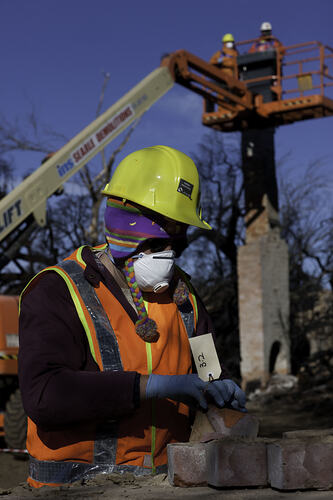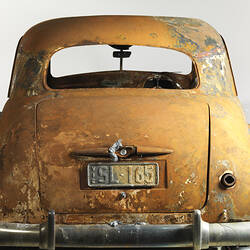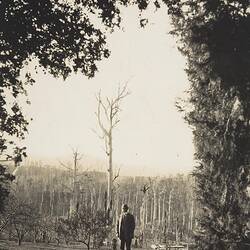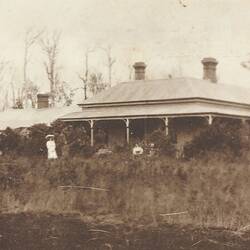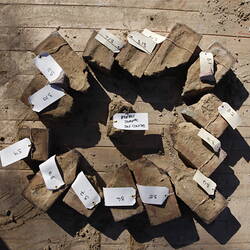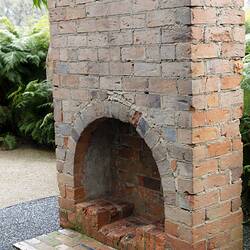In June 2009 Museum Victoria and the local Kinglake Grocon team dismantled a 7-metre-high chimney from a property on the Whittlesea-Kinglake Road. This was one of the few remaining chimneys from homes destroyed in the fires still standing. Most chimneys were demolished in the first weeks following Black Saturday.
Collecting a 'bushfire chimney' posed a range of challenges: locating a suitable chimney, mobilizing a range of specialists to assist in its dismantling at short notice, managing its fragility and working on a contaminated site.
The first hurdle was cleared with the assistance of the local Grocon site clearance team, who were able to identify local chimneys that were still standing.
Time was the next concern - the landowner, Mr M. Gill, was very supportive of the project and accepted the additional time required to clear his site.
There was a very real risk that the chimney might collapse. A large tree threatened to fall on it, so the first step in collecting the chimney was to remove this risk prior to the dismantling. Fortunately the tree fell just metres short of the chimney, with a few branches touching the base of the fireplace.
The site was contaminated with asbestos, so close access to the chimney was limited to the curator, operator of the boom platform and the bricklayer. All three had to wear full body suits and masks. Other assistants were also required to wear body suits.
The successful dismantling of the chimney was achieved through the generosity, expertise and equipment of Kinglake Grocon and their local contractors, who worked with Museum Victoria staff. The project partnerships and the commitment of all involved enabled a very quick, careful and effective collecting process. Within a week of being identified and selected, the chimney was dismantled, each brick labelled and stacked on five pallets for removal from the site.
Museum staff, Grocon and their local contractors from Searle Demolition, dismantled, numbered, cleaned, labelled and stacked approximately 1500 bricks in just two days. The curator, Liza Dale-Hallett, numbered each brick to ensure that their original order was documented, prior to them being carefully extracted by George Firczak, the bricklayer. This process was assisted by Lee Allan, the 'Smooth Operator' of the boom platform.
Reconstruction of the chimney in Melbourne Museum's Forest Gallery was tendered to Bret's Bricklaying, from Ringwood North, who have had considerable experience in working on heritage buildings and sites.
Sample mortars were mixed to ensure that mortar in the reconstructed chimney was as close as possible to the original lime mortar. Photographs taken in situ of the chimney's character and physical details were used to assist the process of reconstruction.
Reconstruction of the brickwork was undertaken by Geoffrey Hennessy, who replicated every detail of the chimney, including the cracks and slack in the mortar. The finished product is so close to the original that it appears as if it was simply lifted directly from its original site to the Museum.
References:
Deidre Hawkins (ed), Kinglake - Pioneering Days (1991).
Deidre Hawkins, 'Living Memories - The Uplands', in Mountain Monthly, (August 2009), page 18.
Liza Dale-Hallett, 'Kinglake Chimney Finds New Life at Museum Victoria', in Mountain Monthly, (August 2009), page 36.
More Information
-
Keywords
-
Localities
-
Authors
-
Article types
